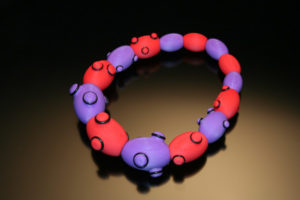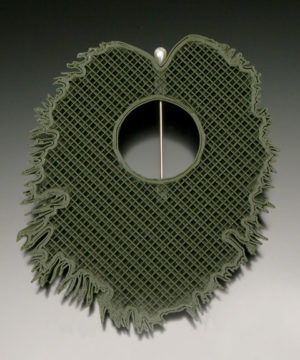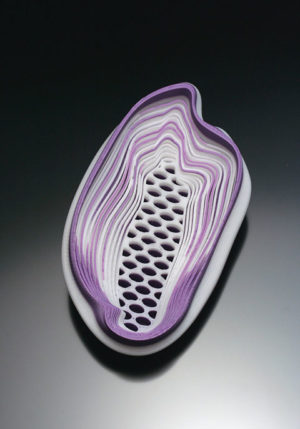Artist’s Talk Focuses on Cutting-Edge Collaborations
Published 03.20.2018
News
Events
An artist and professor who creates sculptural jewelry with 3-D printing technology will share her insights into cutting-edge collaborations at the next talk in the Technology & Society Colloquia Series at Pennsylvania College of Technology.
“Art + Engineering = Creative Problem-Solving” will be presented by 2016-17 Penn State Laureate Rebecca Strzelec, professor of visual arts and program coordinator of visual art studies at Penn State Altoona, on Tuesday, April 10. The 7 p.m. talk, to be held in the Klump Academic Center Auditorium on the Penn College campus, is free and open to the public.
 With 3-D printing technology bringing significant advances in many fields, including health care, architecture, construction, civil engineering, safety, art and design, the phenomenon is one of today’s most talked-about technologies, with some likening it to the start of the third industrial revolution.
With 3-D printing technology bringing significant advances in many fields, including health care, architecture, construction, civil engineering, safety, art and design, the phenomenon is one of today’s most talked-about technologies, with some likening it to the start of the third industrial revolution.
For Strzelec, who trained as a traditional bench jeweler in metals and has converted to an entirely digital studio practice, utilizing computer-aided design, three-dimensional modeling and 3-D printing is simply “another methodology of making.”
“I used to be making things in gold and silver, now I’m making them in bits and bytes on a computer,” she said. “There’s little difference except the specific tools I’m using and how I think about moving forms through space.”
Strzelec recently brought her artist’s eye and insights to a National Science Foundation-funded project focused on origami engineering.
The research project investigated design methods for responsive structures inspired by the ancient art form of origami. The resulting objects have a variety of applications, from minimally invasive surgeries to adaptive aircraft and deployable space structures. It was one of the first times the NSF required an artist to be a co-principal investigator on a grant team as opposed to serving in a consultative role.
 “Scientific advances get lots of attention, but the arts and humanities are another kind of R&D. They’re the cutting edge of how we think about what it means to be human,” Strzelec said.
“Scientific advances get lots of attention, but the arts and humanities are another kind of R&D. They’re the cutting edge of how we think about what it means to be human,” Strzelec said.
The artist, educator and problem-solver says she enjoys using her jewelry to communicate and strives to make objects that function and convey meaningful stories.
 One of Strzelec’s brooches, part of her “Army Green Orchids” series, is in the private collection of former Secretary of State Madeleine Albright, who used pins as her diplomatic signature and later wrote, “Read My Pins: Stories From a Diplomat’s Jewel Box.” Taking a cue from Albright, Strzelec wore jewelry, inherited from her grandmother, during her term as Penn State Laureate. She documented wearing a different piece of jewelry every day for a year on Instagram as #365grams. She is now in the phase of taking apart that jewelry to reconfigure and refine it.
One of Strzelec’s brooches, part of her “Army Green Orchids” series, is in the private collection of former Secretary of State Madeleine Albright, who used pins as her diplomatic signature and later wrote, “Read My Pins: Stories From a Diplomat’s Jewel Box.” Taking a cue from Albright, Strzelec wore jewelry, inherited from her grandmother, during her term as Penn State Laureate. She documented wearing a different piece of jewelry every day for a year on Instagram as #365grams. She is now in the phase of taking apart that jewelry to reconfigure and refine it.
A self-proclaimed “trash picker,” Strzelec regularly climbs into dumpsters and rummages through thrift stores and yard sales looking for objects and inspirations for her work. The combination of old finds and new technologies are a dynamic aspect of her creative process. The artist says she pines for “the idea of quality and legacy” found in artifacts and strives to craft objects via today’s technologies that hold those same qualities.
In keeping with the focus of the Technology & Society Colloquia Series, which aims to challenge audiences to consider the impact of technology on society, Strzelec’s talk will touch upon the mutuality of technology and the arts, and the need for a collective conversation and understanding to advance alongside technology.
 “As our world speeds up, thanks to technology, the individual sometimes gets lost in the fray. The arts and humanities remind us to reflect upon the whole person and, ultimately, our whole society,” she said.
“As our world speeds up, thanks to technology, the individual sometimes gets lost in the fray. The arts and humanities remind us to reflect upon the whole person and, ultimately, our whole society,” she said.
Strzelec earned Bachelor of Fine Arts and Master of Fine Arts degrees in metals/jewelry/CAD-CAM from Tyler School of Art, Temple University.
Her works are included in two current traveling exhibitions: “Plastic Entanglements: Ecology, Aesthetics, Materials,” organized by Penn State’s Palmer Museum of Art, and “I.M.A.G.I.N.E. Peace Now,” an innovative merger of art and guns. An art book published last year – “CAST: Art and Objects Made Using Humanity’s Most Transformational Process” – also showcases her contemporary creations.
Strzelec’s Army Green Orchids were featured in “Out of Hand: Materializing the Post Digital” at the Museum of Arts and Design, in New York. The 2014 exhibition was the first major museum exhibition examining the interdisciplinary trend of digital fabrication fine art.
Her artwork is included in permanent collections at numerous museums and has been presented in over 65 national and international exhibits.
A question-and-answer period will follow the presentation in the auditorium; the conversation can also resume during a reception that will follow downstairs in the Wrapture dining unit.
Honoring Daniel J. Doyle, professor emeritus and Penn College’s 1984 Master Teacher, the Colloquia Series features presentations by noted authors and academics. The series was launched in 2014 as the Centennial Colloquia Series, as the college celebrated its 100th year of education.
For more about Penn College, a national leader in applied technology education, email the Admissions Office or call toll-free 800-367-9222.
“Art + Engineering = Creative Problem-Solving” will be presented by 2016-17 Penn State Laureate Rebecca Strzelec, professor of visual arts and program coordinator of visual art studies at Penn State Altoona, on Tuesday, April 10. The 7 p.m. talk, to be held in the Klump Academic Center Auditorium on the Penn College campus, is free and open to the public.
 With 3-D printing technology bringing significant advances in many fields, including health care, architecture, construction, civil engineering, safety, art and design, the phenomenon is one of today’s most talked-about technologies, with some likening it to the start of the third industrial revolution.
With 3-D printing technology bringing significant advances in many fields, including health care, architecture, construction, civil engineering, safety, art and design, the phenomenon is one of today’s most talked-about technologies, with some likening it to the start of the third industrial revolution.For Strzelec, who trained as a traditional bench jeweler in metals and has converted to an entirely digital studio practice, utilizing computer-aided design, three-dimensional modeling and 3-D printing is simply “another methodology of making.”
“I used to be making things in gold and silver, now I’m making them in bits and bytes on a computer,” she said. “There’s little difference except the specific tools I’m using and how I think about moving forms through space.”
Strzelec recently brought her artist’s eye and insights to a National Science Foundation-funded project focused on origami engineering.
The research project investigated design methods for responsive structures inspired by the ancient art form of origami. The resulting objects have a variety of applications, from minimally invasive surgeries to adaptive aircraft and deployable space structures. It was one of the first times the NSF required an artist to be a co-principal investigator on a grant team as opposed to serving in a consultative role.
 “Scientific advances get lots of attention, but the arts and humanities are another kind of R&D. They’re the cutting edge of how we think about what it means to be human,” Strzelec said.
“Scientific advances get lots of attention, but the arts and humanities are another kind of R&D. They’re the cutting edge of how we think about what it means to be human,” Strzelec said.The artist, educator and problem-solver says she enjoys using her jewelry to communicate and strives to make objects that function and convey meaningful stories.
 One of Strzelec’s brooches, part of her “Army Green Orchids” series, is in the private collection of former Secretary of State Madeleine Albright, who used pins as her diplomatic signature and later wrote, “Read My Pins: Stories From a Diplomat’s Jewel Box.” Taking a cue from Albright, Strzelec wore jewelry, inherited from her grandmother, during her term as Penn State Laureate. She documented wearing a different piece of jewelry every day for a year on Instagram as #365grams. She is now in the phase of taking apart that jewelry to reconfigure and refine it.
One of Strzelec’s brooches, part of her “Army Green Orchids” series, is in the private collection of former Secretary of State Madeleine Albright, who used pins as her diplomatic signature and later wrote, “Read My Pins: Stories From a Diplomat’s Jewel Box.” Taking a cue from Albright, Strzelec wore jewelry, inherited from her grandmother, during her term as Penn State Laureate. She documented wearing a different piece of jewelry every day for a year on Instagram as #365grams. She is now in the phase of taking apart that jewelry to reconfigure and refine it.A self-proclaimed “trash picker,” Strzelec regularly climbs into dumpsters and rummages through thrift stores and yard sales looking for objects and inspirations for her work. The combination of old finds and new technologies are a dynamic aspect of her creative process. The artist says she pines for “the idea of quality and legacy” found in artifacts and strives to craft objects via today’s technologies that hold those same qualities.
In keeping with the focus of the Technology & Society Colloquia Series, which aims to challenge audiences to consider the impact of technology on society, Strzelec’s talk will touch upon the mutuality of technology and the arts, and the need for a collective conversation and understanding to advance alongside technology.
 “As our world speeds up, thanks to technology, the individual sometimes gets lost in the fray. The arts and humanities remind us to reflect upon the whole person and, ultimately, our whole society,” she said.
“As our world speeds up, thanks to technology, the individual sometimes gets lost in the fray. The arts and humanities remind us to reflect upon the whole person and, ultimately, our whole society,” she said.Strzelec earned Bachelor of Fine Arts and Master of Fine Arts degrees in metals/jewelry/CAD-CAM from Tyler School of Art, Temple University.
Her works are included in two current traveling exhibitions: “Plastic Entanglements: Ecology, Aesthetics, Materials,” organized by Penn State’s Palmer Museum of Art, and “I.M.A.G.I.N.E. Peace Now,” an innovative merger of art and guns. An art book published last year – “CAST: Art and Objects Made Using Humanity’s Most Transformational Process” – also showcases her contemporary creations.
Strzelec’s Army Green Orchids were featured in “Out of Hand: Materializing the Post Digital” at the Museum of Arts and Design, in New York. The 2014 exhibition was the first major museum exhibition examining the interdisciplinary trend of digital fabrication fine art.
Her artwork is included in permanent collections at numerous museums and has been presented in over 65 national and international exhibits.
A question-and-answer period will follow the presentation in the auditorium; the conversation can also resume during a reception that will follow downstairs in the Wrapture dining unit.
Honoring Daniel J. Doyle, professor emeritus and Penn College’s 1984 Master Teacher, the Colloquia Series features presentations by noted authors and academics. The series was launched in 2014 as the Centennial Colloquia Series, as the college celebrated its 100th year of education.
For more about Penn College, a national leader in applied technology education, email the Admissions Office or call toll-free 800-367-9222.